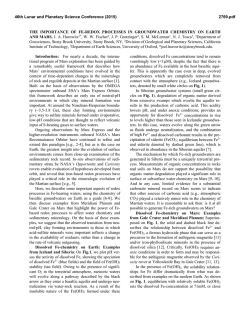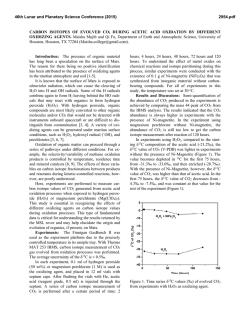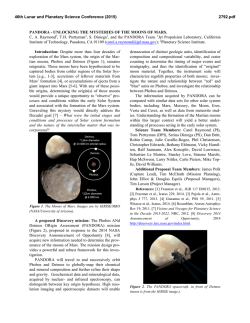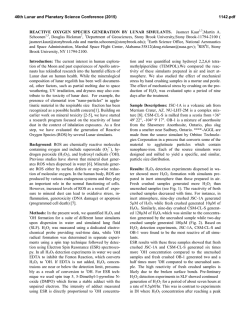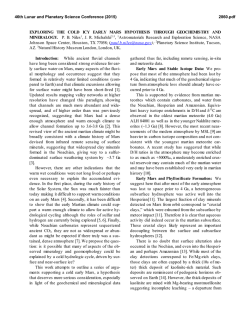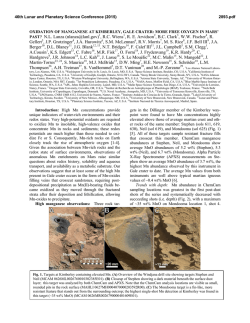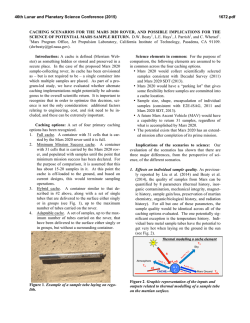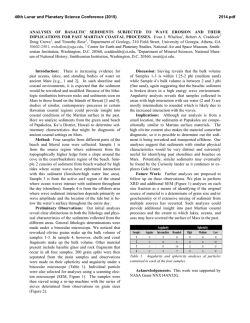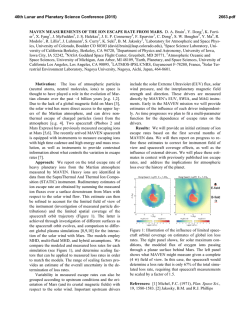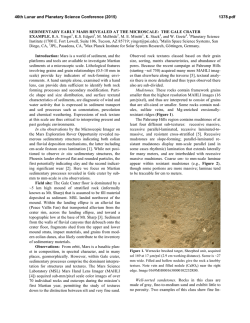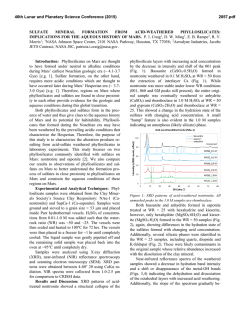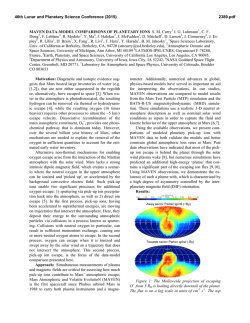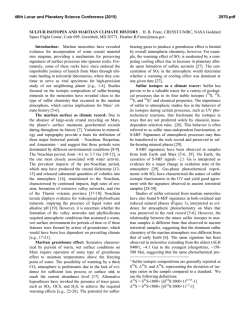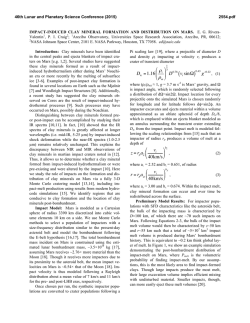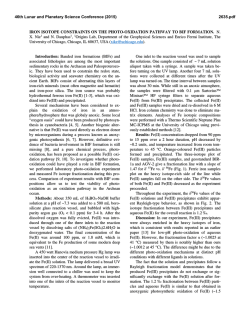
Influence of Redox Conditions on the Secondary Mineralogy of Early
46th Lunar and Planetary Science Conference (2015) 1225.pdf INFLUENCE OF REDOX CONDITIONS ON THE SECONDARY MINERALOGY OF EARLY MARS. E. Dehouck1, A. Gaudin2, V. Chevrier3 and N. Mangold2. 1Department of Geosciences, State University of New York at Stony Brook, Stony Brook, NY 11794-2100, USA ([email protected]), 2Laboratoire de Planétologie et Géodynamique de Nantes (LPGN), CNRS/Université de Nantes, 44322 Nantes, France, 3Arkansas Center for Space and Planetary Sciences, University of Arkansas, Fayetteville, AR 72701, USA. Introduction: The reddish coloration of Mars, easily discernible from Earth with the naked eye, is due to the widespread occurrence of oxidized, ferric iron (Fe3+) in surface dust and soils. This long-recognized oxidation of the martian surface is thought to result mainly from geologically recent (i.e., amazonian) processes that did not involve liquid water, but instead gassolid reactions [e.g., 1,2]. However, the presence of oxidants or oxidation mechanisms does not have to be restricted to the most recent geological era. The sedimentary record of Meridiani Planum – dated from the late Noachian or early Hesperian [3] – requires strong oxidation to account for the Fe-mineralogy observed by the Opportunity rover (hematite, ferric sulfates) [e.g., 4]. Moreover, it has been proposed that the strongly acidic conditions implied by the presence of jarosite resulted either from the oxidation of Fe-sulfides [5,6] or solely by the oxidation of dissolved Fe2+ [7]. Therefore, the occurrence of oxidants or oxidation mechanisms may have played a key role in the alteration processes all along the history of Mars. In the past years, a series of weathering experiments conducted under CO2 atmospheres has explored the effects of poorly-oxidizing versus highly oxidizing conditions, through the use of hydrogen peroxide (H2O2). After reviewing the possible oxidants and oxidation mechanisms on early Mars, this paper draws a general vision of the influence of redox conditions on alteration pathways. In particular, new data are presented to support the idea that poorly-oxidizing conditions were required to form the widespread Fe/Mg-smectites on early Mars. Oxidation on Mars: Primitive atmospheres of terrestrial planets were mainly composed of N2, CO2, CH4 and perhaps H2 [e.g., 8]. Therefore, reducing conditions are the norm on planetary surfaces, whereas oxidizing conditions require additional processes to occur. On Earth, photosynthetic organisms are largely responsible for the current oxidizing conditions that prevail in most surficial environments, through the sustained fixation of atmospheric CO2 and liberation of O2. On Mars, evidence that photosynthetic life forms ever existed remains to be discovered. However, several non-biological processes capable of creating oxidizing conditions may have occured on early Mars. Oxidation of ferrous iron can take place by two different ways: (1) direct photo-oxidation of dissolved Fe2+; or (2) chemical reaction between a photochemi- cally-produced oxidant and dissolved Fe2+ [e.g., 7,9]. In addition to ultraviolet light, both mechanisms require H2 loss into space to obtain net oxidation at a global scale [7,9]. Both also have their limitations. For example, photo-oxidation requires direct exposure of Fe2+-bearing fluids to UV light. Catling and Moore [9] also pointed out that the spontaneous formation of ironsilicate gels may prevent the photo-oxidation of Fe2+ in silica-rich fluids. Chemical oxidation is limited by the transport toward the surface of oxidants produced by photochemical reactions in the atmosphere. On the other hand, dissolved oxidants such as O2 or H2O2 can percolate into the ground and thus induce oxidation within soils or sediments protected from direct UV exposure [7,10]. Therefore, although the long-term main– tenance of oxidizing conditions may have been challenging due to volcanic release of reducing gases [9], a combination of photo-oxidation and chemical oxidation may have been sufficient to create at least episodic and/or local oxidizing conditions on the surface of Mars, as evidenced in Meridiani Planum. Effects of redox conditions on secondary mineralogy: In the past years, our group has presented several laboratory experiments [5,6,11,12] aiming at a better understanding of alteration reactions of primary materials under simulated early Mars conditions (CO2rich, humid atmosphere, with or without H2O2). Here, we focus on the effects of redox conditions on the weathering of primary silicates and then briefly review the effects on silicate+sulfide mixtures. Methods summary. Experimental methods are described in details in [5,6,11]. Briefly, powdered samples of primary materials were placed in the middle of vacuum dessicators, the bottom of which was filled with either H2O only or H2O+H2O2. Contact between solid and liquid phases thus occurred through evaporation and precipation cycles, implying low water-to-rock ratios. The internal atmosphere of the dessicators was pumped and replaced by CO2. Experiments were run at room temperature for up to several years. Effects on smectite formation. Here we present new analyses of samples of olivine and orthopyroxene (“Ol1” and “OPx” in [6]) weathered during four years under CO2. Although these samples were much less modified than the corresponding mixtures with sulfide (see below), a careful study of their near-infrared spectra reveals absorption bands at 2.31 and 2.39 µm asso- 46th Lunar and Planetary Science Conference (2015) ciated with Mg-rich smectite clays (Fig. 1). In the case of olivine, these bands are present for the sample weathered in poorly-oxidizing conditions (i.e., without H2O2, named “H2O” in Fig. 1), while they are absent for the initial sample and for the sample weathered in strongly oxidizing conditions. In the case of orthopyroxene, the initial sample displays shallow bands at these positions due to pre-experiment alteration. However, the band depths clearly increased for the sample weathered without H2O2, whereas they remained stable for the one weathered with H2O2. The formation of smectite clays (or precursors) is further confirmed in the Ol1-H2O and OPx-H2O samples by the observation by SEM of “filaments” similar in size and morphology to those observed in [12] (Fig. 2). These filaments are absent from the initial samples and from the samples weathered with H2O2. Effects on silicate+sulfide mixtures. In addition to pure silicates, the experiment presented in [6] studied the weathering of silicate+sulfide mixtures (the sulfide component being hexagonal pyrrhotite). Secondary phases were similar in nature with or without H2O2 and consisted of elemental sulfur, (Mg-, Ca-, Fe-)sulfates and Fe(hydr)oxides. However, it was observed that elemental sulfur was always in lower abundance in samples weathered with H2O2, while sulfates were higher. Conclusion: The new results presented in this abstract about the influence of redox conditions on the formation of Mg-rich smectites under CO2 confirm those obtained from our other experimental weathering of olivine conducted at higher water-to-rock ratio [12]. The fact that these results can now be extended to orthopyroxene demonstrates that this effect potentially applies to the entire surface of Mars, and not just regions with high olivine content. We have shown that strong oxidants would have inhibited the formation of widespread Fe/Mg-smectites on early Mars. This is due to the fact that purely Mgsmectites are not stable at the relatively low pH associated with a CO2 atmosphere [12]. This implies that reducing conditions prevailed during the era where most clays were formed, perhaps due to the release of reducing gases by volcanoes, which may have prevented net oxidation despite H2 escape [9]. Strong oxidants may have played a more important role in later alteration episodes leading to the formation of abundant sulfates, even though their presence is not required to explain the observed mineralogy of Meridiani Planum [6]. References: [1] Gooding J. (1978) Icarus, 33, 483513. [2] Bibring J.-P. et al. (2006) Science, 312, 400-404 [3] Hynek B. M. et al. (2002) JGR, 107, E10-5088 [4] McLennan S. M. et al. (2005) EPSL, 240, 95-121 [5] Chevrier V. et al. (2006) GCA, 70, 4295-4317 [6] Dehouck E. et al. (2012) GCA, 90, 47-63 [7] Hurowitz J. A. 1225.pdf et al. (2010) Nat. Geosci., 3, 323-326 [8] Pollack J. B. and Yung Y. L. (1980) Ann. Rev. Earth Planet. Sci., 8, 425-487 [9] Catling D. and Moore J. M. (2003) Icarus, 165, 277-300 [10] Bullock et al., 1994 [11] Chevrier V. et al. (2004) Geology, 32, 1033-1036. [12] Dehouck E. et al. (2014) GCA, 135, 170-189. Fig. 1 – Continuum-removed spectra of olivine and orthopyroxene samples before and after alteration under CO2 atmospheres. Absorptions bands at 2.31 and 2.39 µm are typical of Mg-rich smectites. Fig. 2 – SEM micrograph of an olivine grain weathered under a CO2-rich, H2O2-free atmosphere.
© Copyright 2025
